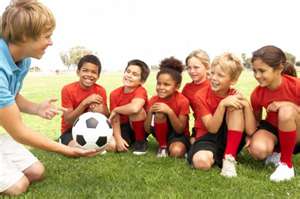

Recent news reports show an increase in sports-related injuries. Heat exhaustion, concussions, knee injuries, and heart problems all have resulted in a growing concern about kids’ sports safety among safety advocates, doctors and parents. These Tips for Parents will show you what the risks are and how to decrease or prevent risk of injury.
What are the risks?
Anytime one engages in sports activities, there is an inherent risk. However, some sports and activities carry higher risks for certain injuries.
Baseball: Elbow, shoulder, leg, foot and back injuries are frequently associated with America’s pastime sport. Broken jaws, black eyes, concussions, cracked teeth and heat stroke/exhaustion also commonly occur.
Basketball: The most injuries among kids’ sports occur in basketball. Players in this sport are more likely to experience knee and ankle injuries, both from accidents and overuse. Finger, eye and teeth injuries also are common in basketball.
Football: Football players are at a higher risk for ankle, finger, knee, shoulder and eye injuries. Additionally, serious low back stress fractures and concussions are seen in this sport.
Gymnastics: Bruises, stress fractures, strains and sprains, tendinitis and growth plate injuries are all common injuries associated with gymnastics. An emphasis on thinness among gymnasts means increased incidence of eating disorders such as anorexia and bulimia.
 Jogging/Running: The injuries most frequently seen among child and teen runners and joggers are overuse injuries in the legs, knees, back, ankles, feet and hips.
Jogging/Running: The injuries most frequently seen among child and teen runners and joggers are overuse injuries in the legs, knees, back, ankles, feet and hips.
Soccer: Ankle, knee, heel, mouth, face, teeth, and eye injuries are associated with soccer. Head injuries, in particular concussions, are also frequently seen among soccer players.
Softball: Shoulder injuries are among the most frequent softball injuries. Wrist, hand and back injuries are also seen.
Wresting: Wrestling is responsible for the second highest rate of injury among typical student sports. Knee cap injuries are the most common. Injuries to the legs, feet, knees, hands, head and neck are also associated with this sport, as well as cauliflower ear, increased risk of anabolic steroid use, eating disorders and skin infections.

Decreasing the Risk of Kids’ Sports Injuries
These tips are designed to help parents prevent injury among their sporting children:
- Wear appropriate safety gear, such as helmets, eye protection, mouth guards, etc.
- Pay attention to warm ups and cool downs.
- Teach children to listen to their bodies and to understand the difference between challenging yourself to do better and injuring yourself.
- Help kids to get in good physical shape before beginning the sport.
- Only allow kids to play with others of similar size and ability.
- Encourage good sportsmanship, fair play, and following the rules of the game.
- Ensure that sports equipment and facilities are well maintained.
- Coaches should be First Aid and CPR Certified.
- Drink plenty of water.
- Avoid over-exertion, especially in higher temperatures.
- Maintain good nutrition.
For More Information:
HealthyChildren.org’s Sports Articles
SafeKidsUSA’s Sport Injury Prevention Tips
You may also be interested in this related Tips for Parents:
Tips for Parents: Summer Safety
ABOUT:

